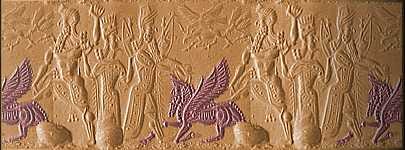Blog
In those days, in those far-off days
Tags: History, Books, Literature, Iraq, Gilgamesh
Update on The Epic of Gilgamesh
 Source: http://www.mesopotamia.co.uk/gods/explore/bullheav.html
Source: http://www.mesopotamia.co.uk/gods/explore/bullheav.html
As I am finishing up my reading of The Epic of Gilgamesh, I started this morning on the portion of the Sumerian poems used as the source for Tablet XII. The stark difference in tone and style was immediately noticeable, and this difference, along with the inconsistencies it introduces by way of involving a living Enkidu has caused scholars to consider it an “inorganic appendage” to the main epic.
Regardless of its provenance, intention, and import, I find this poem more elegant than the standard version, the first eleven tablets. Perhaps this is in part due to the fragmentary nature of the main epic. Repetition is a notable feature of ancient works, which were only written down after an unknown amount of time as oral traditions. As oral traditions, fidelity of reproduction was vital, and it seems various methods of memorization were developed to both aid this process and to strengthen the form and content. Precisely what styles the Sumerian scribes used, we can’t be sure. Whatever the case, repitition is important in all parts of the epic, but it takes on an almost liturgical character in what became Tablet XII.
In those days, in those far-off days,
In those nights, in those far-off nights,
In those years, in those far-off years,
The whole poem flows like this, building on itself as it relates the story of Enkidu’s descent into the underworld to fetch some items of Gilgamesh’s that were dropped there, and Gilgamesh’s attempts to get his friend back from the underworld. Reading this, I can just about smell the high-church incense and hear this uttered from the lips of a priest.
Re: Memorization
Any time I think about the repetitive patterning in ancient works drawn from oral tradition, I recall a Ribbonfarm post that touches on that topic as it applies to ancient India and the memorization practices of those preserving the Vedas. The assertion is that the memorization practices would have made it harder to memorize, not easier, but by extension force the scribe to pay attention to the text itself. We can’t necessarily know whether the Sumerians practiced a similar set of methods, but we can see the remains of their handiwork in the cuneiform tablets they left behind. Copying these over and over was the work of apprentice scribes, who, according to a 2012 article published in the Journal of Near Eastern Studies, appear to have been working primarily from memory. It would be fascinating to uncover evidence of their memorization methods, but we should surmise that extensive repetition played a key part.